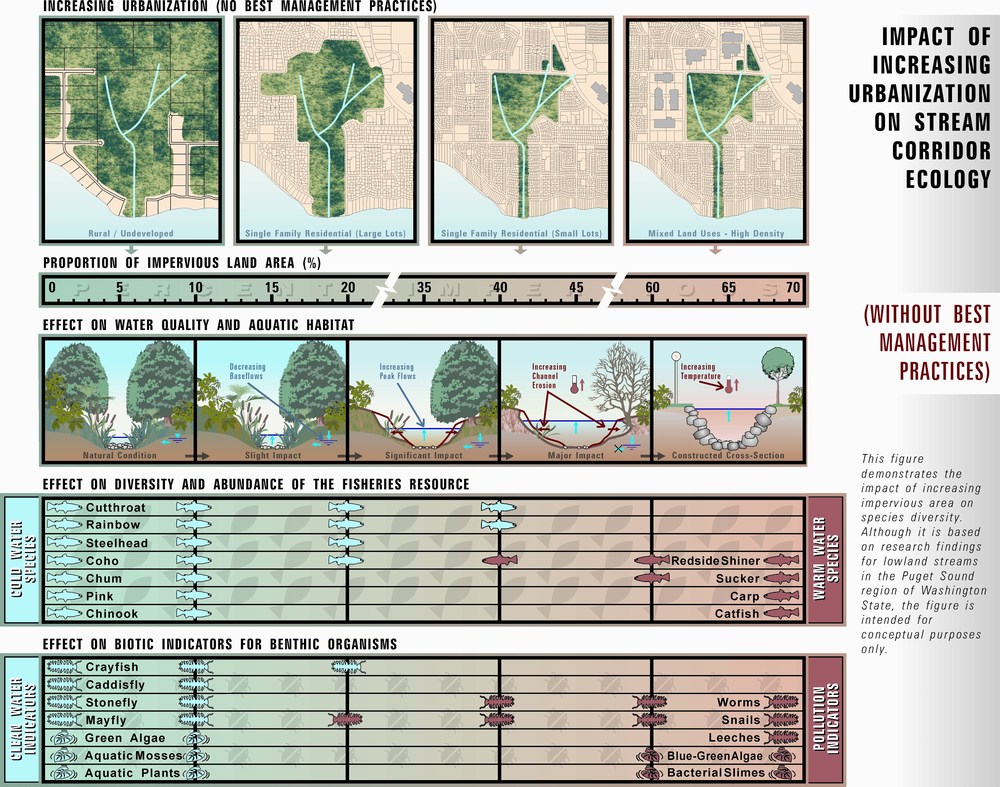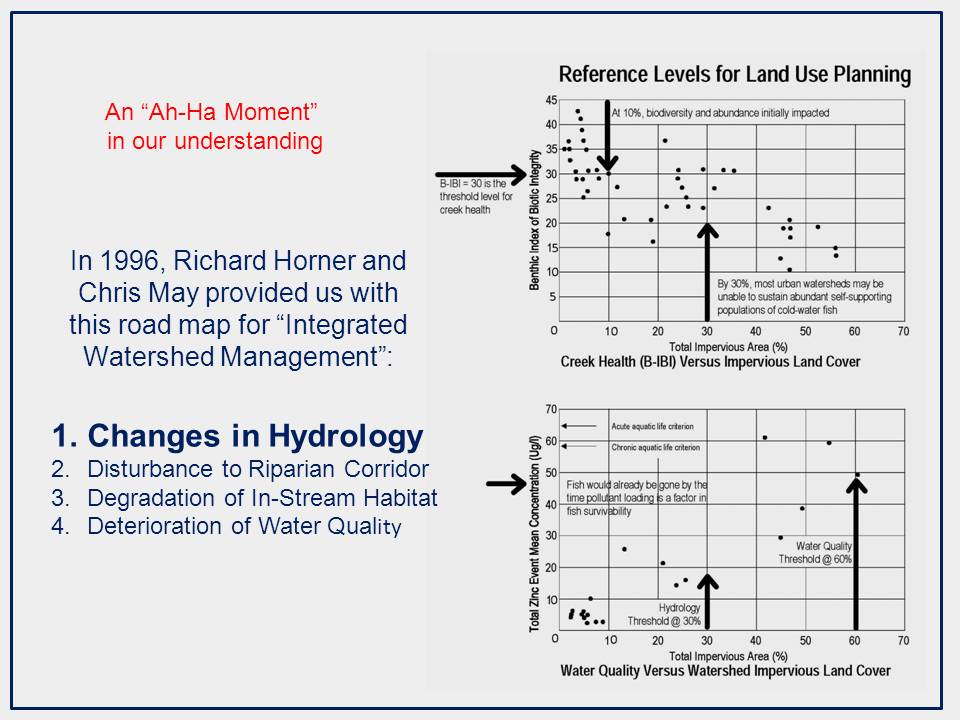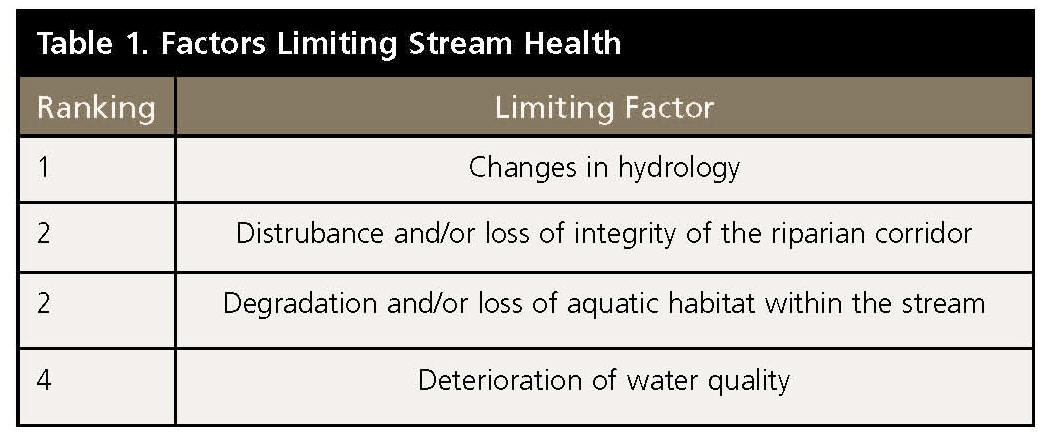"In the 1990s, Puget Sound research by Horner and May made it clear that stormwater management was as much or more about land use decisions as engineering solutions," recalls Bill Derry, watershed champion
To Protect Watershed Health, Understand the Watershed as a Whole System
Washington State research informed the early implementation of British Columbia’s Fish Protection Act (1997), the first legislation of its kind in Canada. In the mid-1990s, the pioneer work of Dr. Richard Horner and Dr. Chris May (University of Washington, Seattle) was transformational. Their findings resulted in a hydrology-based framework for protecting watershed health.
The framework provided a starting point for applying science-based understanding to reinvent drainage engineering practice, commencing with release of Stormwater Planning: A Guidebook for British Columbia in 2002.
A Watershed is a Whole System
 “So many studies manipulate a single variable out of context with the whole and its many additional variables,” states Dr. Richard Horner, now an adjunct professor at the University of Washington. “We, on the other hand, investigated whole systems in place, tying together measures of the landscape, stream habitat, and aquatic life.” Richard Horner founded the Center for Urban Water Resources Management in 1990.
“So many studies manipulate a single variable out of context with the whole and its many additional variables,” states Dr. Richard Horner, now an adjunct professor at the University of Washington. “We, on the other hand, investigated whole systems in place, tying together measures of the landscape, stream habitat, and aquatic life.” Richard Horner founded the Center for Urban Water Resources Management in 1990.
 “The key to the Whole Systems approach is understanding the integrated significance of the three flow paths in a watershed – surface runoff, lateral interflow in shallow soils, and deep groundwater. Unlock that key and we can successfully implement appropriate measures so that creek systems are more resilient and therefore able to better cope with an altered flow regime,” continues Dr. Chris May, now Surface & Stormwater Division Director with Kitsap County Public Works in Washington State.
“The key to the Whole Systems approach is understanding the integrated significance of the three flow paths in a watershed – surface runoff, lateral interflow in shallow soils, and deep groundwater. Unlock that key and we can successfully implement appropriate measures so that creek systems are more resilient and therefore able to better cope with an altered flow regime,” continues Dr. Chris May, now Surface & Stormwater Division Director with Kitsap County Public Works in Washington State.
To Learn More:
The most complete reference to all stream research undertaken by Richard Horner and Chris May is their final report to the United States Environmental Protection Agency, published in 2004.
For an historical perspective on implementation of the hydrology-based framework in BC, click on Rainwater Management in a Watershed Context – What’s the Goal?

Impact of Land Use Decisions on Aquatic Diversity and Abundance (Source: Stormwater Planning: A Guidebook for British Columbia, 2002)
Four Factors Limit Stream Health
“In 1996, Richard Horner and Chris May published a seminal paper that synthesized a decade of Puget Sound research to identify and rank the four factors that degrade urban streams and negatively influence aquatic productivity and fish survival (Table 1 below). This science-based ranking provides a framework for Integrated Watershed  Management,” reports Bill Derry. In the 1980s, he was one of the first stormwater utility managers in Washington State.
Management,” reports Bill Derry. In the 1980s, he was one of the first stormwater utility managers in Washington State.
“When published, this ranking (Table 1) shook conventional stormwater management wisdom in the Pacific Northwest to its foundation. This research made it clear that stormwater management was as much or more about land use decisions as engineering solutions. We also learned that we needed to address transportation choices.”
Bill Derry believed so strongly in the need for scientifically defensible research that he convinced his fellow utility managers to organize and fund the research centre founded by Richard Horner. Bill Derry communicated the science in a way that was easy for his audiences to understand. In the latter half of the 1990s, his teaching resonated with local governments in British Columbia.
Genesis for Cross-Border Collaboration With Washington State
“Washington State and British Columbia are geographically similar, with a wet coast and a relatively dry interior separated by mountain ranges,” states Kim Stephens, Executive Director of the Partnership for Water Sustainability, and principal author of British Columbia’s Stormwater Guidebook. In the late 1990s, Kim Stephens teamed with Bill Derry to inform and educate local government practitioners in BC about application of science-based understanding to protect salmon habitat.
“On the coast, Washington State’s Puget Sound and British Columbia’s Georgia Basin together comprise the Salish Sea. The bulk of the two populations reside in this Pacific Northwest bio-region. In terms of how rainwater management in a watershed context has evolved, there is a history of cross-border sharing and collaboration.”
A Shared Goal to Protect Salmon Habitat
“The catalyst for collaboration was the salmon crisis of the 1990s,” continues Kim Stephens. “On both sides of the border, the salmon is an icon. It is also the early warning system that there is a problem. Coastal salmon runs such as coho, chum and pink spawn and rear in the headwater streams which are typically small and their ecosystem value was not fully appreciated a generation ago. The result: streams were being lost as a consequence of rapid population growth and land development.”
“This lack of understanding and respect contributed to the decline of many wild salmon populations. And so the goal of protecting stream health became a driver for action on both sides of the border. An environmental ethic led some water resource practitioners to re-think how we design and build communities.”
“Among those leading change in the 1990s, Bill Derry has had a profound influence on both sides of the border. His contributions and accomplishments started with his leadership role in the founding of the Center for Urban Water Resources Management. Over a long period of time, his impact on practitioner thinking resulted from his skill at communicating the science in a way that resonated with local government audiences. The ripple effects of his cross-border teaching in BC are far-reaching.”
To Learn More:
Click on Bill Derry of Washington State issues call for action in Puget Sound



